Meade LX90 User Manual
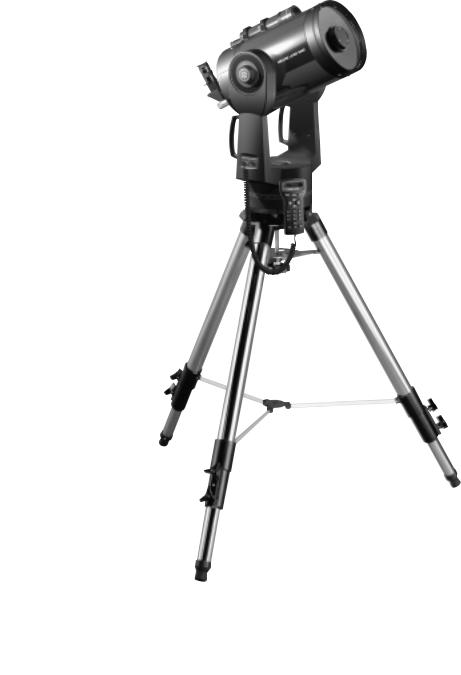
Instruction Manual
8" LX90 Schmidt-Cassegrain Telescope with Autostar Hand Controller
 Meade Instruments Corporation
Meade Instruments Corporation
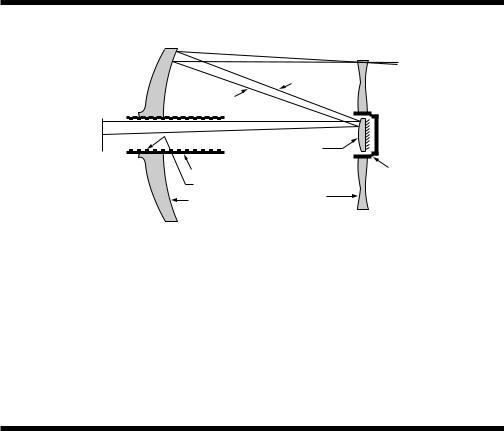
The Meade Schmidt-Cassegrain Optical System
|
(2) |
(1) |
|
|
|
(1) |
|
(2) |
|
|
Ray (2) |
Ray (1) |
|
|
(2) |
|
|
(1) |
|
Secondary |
|
|
|
Focal |
|
Mirror |
|
|
|
Plane |
|
Secondary |
Primary Baffle Tube |
|
Baffle |
Field Stops |
|
Correcting |
|
|
|
Primary Mirror |
|
Plate |
|
|
In the Schmidt-Cassegrain design of the Meade LX90, light enters from the right, passes through a thin lens with 2-sided aspheric correction (“correcting plate”), proceeds to a spherical primary mirror, and then to a convex secondary mirror. The convex secondary mirror multiplies the effective focal length of the primary mirror and results in a focus at the focal plane, with light passing through a central perforation in the primary mirror.
The Meade 8" LX90 Schmidt-Cassegrain includes an oversize primary mirror of an 8.25" diameter, yielding a fully illuminated field-of-view significantly wider than is possible with a standard-size primary mirror. Note that light ray (2) in the figure would be lost entirely, except for the oversize primary. It is this phenomenon which results in Meade SchmidtCassegrains having off-axis field illuminations about 10% greater, aperture-for-aperture, than other Schmidt-Cassegrains utilizing standard-size primary mirrors. Field stops machined into the inside-diameter surface of the primary mirror baffle tube significantly increase lunar, planetary, and deep-space image contrast. These field stops effectively block off-axis stray light rays.
® The name "Meade" and the Meade logo are trademarks registered with the U.S. Patent Office and in principal countries throughout the world. "LX90" is a trademark of Meade Instruments Corporation.
© 2000 Meade Instruments Corporation.

WARNING!
Never use a Meade® LX90 Telescope to look at the Sun! Looking at or near the Sun will cause instant and irreversible damage to your eye. Eye damage is often painless, so there is no warning to the observer that damage has occurred until it is too late. Do not point the telescope or its viewfinder at or near the Sun. Do not look through the telescope or its viewfinder as it is moving. Children should always have adult supervision while observing.
CAUTION: Use care to install batteries in the orientation indicated by illustration in the battery slots of the battery holder. Follow battery manufacturer's precautions. Do not install batteries backwards or mix new and used batteries. Do not mix battery types. If these precautions are not followed, batteries may explode, catch fire, or leak. Improperly installed batteries void your Meade warranty.
If you are anxious to use your telescope for the first time, read the QUICK-START GUIDE on pages 4 and 5.
CONTENTS |
|
Quick-Start Guide .......................................................... |
4 |
Telescope Features ...................................................... |
6 |
Autostar Features .......................................................... |
9 |
Getting Started .............................................................. |
12 |
Parts Listing .............................................................. |
12 |
How to Attach the Tripod to the Telescope .............. |
12 |
How to Assemble Your Telescope ............................ |
12 |
Choosing an Eyepiece .............................................. |
14 |
Mounting and Adjusting the Viewfinder .................... |
14 |
Observing ...................................................................... |
15 |
Observing By Moving the Telescope Manually ........ |
15 |
Terrestrial Observing ................................................ |
15 |
Observing Using Autostar's Arrow Keys .................. |
15 |
Slew Speeds ............................................................ |
16 |
Observe the Moon .................................................... |
16 |
Astronomical Observing ............................................ |
17 |
To Track an Object Automatically.............................. |
17 |
Alt/Az Home Position .......................................... |
17 |
Moving Through Autostar’s Menus...................... |
17 |
Initializing Autostar .............................................. |
17 |
Observe a Star Using Automatic Tracking .......... |
18 |
Easy (Two-Star) Align .............................................. |
19 |
Go To Saturn ............................................................ |
20 |
Using the Guided Tour .............................................. |
20 |
Basic Autostar Operation................................................ |
21 |
Autostar Navigation Exercise .................................... |
21 |
Entering Data into Autostar ...................................... |
22 |
Navigating Autostar .................................................. |
22 |
Menus and Menu Options .............................................. |
23 |
Complete Autostar Menu Structure .......................... |
23 |
Objects Menu............................................................ |
23 |
Event Menu .............................................................. |
24 |
Glossary Menu.......................................................... |
25 |
Utilities Menu ............................................................ |
25 |
Setup Menu .............................................................. |
26 |
Advanced Autostar Features .......................................... |
29 |
Adding Observing Sites ............................................ |
29 |
Finding Objects Not in the Database........................ |
30 |
Observing Satellites .................................................. |
31 |
How to Create Your Own Guided Tour .................... |
32 |
Landmarks ................................................................ |
35 |
Identify ...................................................................... |
36 |
Advanced Alt/Az Alignment ...................................... |
37 |
Browse ...................................................................... |
37 |
Photography with the LX90 ............................................ |
38 |
Optional Accessories ...................................................... |
39 |
Maintenance .................................................................. |
41 |
Collimation .......................................................... |
41 |
Inspecting the Optics .......................................... |
43 |
Gauging the Movement of the Telescope............ |
43 |
Meade Customer Service.................................... |
43 |
Specifications ...................................................... |
44 |
Appendix A: Equatorial (Polar) Alignment ...................... |
45 |
Appendix B: Helpful Charts ............................................ |
48 |
Appendix C: Training the Drive ...................................... |
49 |
Basic Astronomy ............................................................ |
50 |
A Roadmap to the Stars ................................................ |
52 |
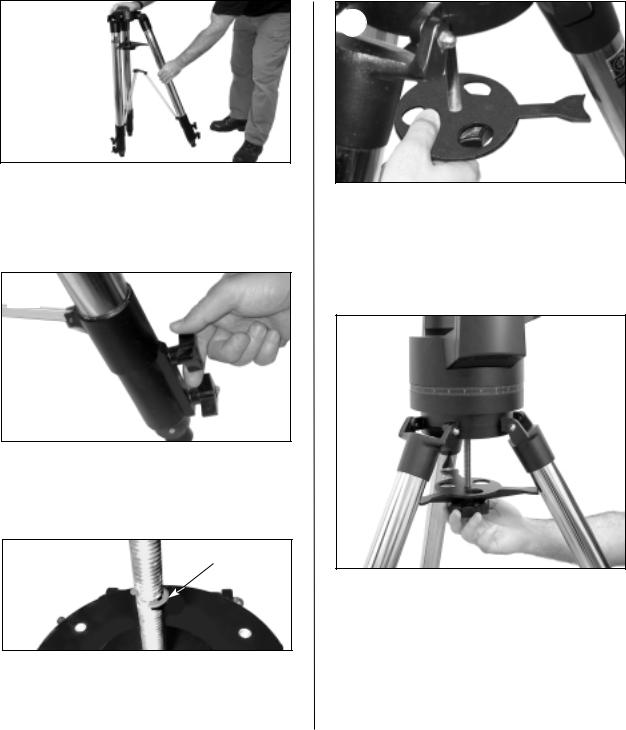
QUICK-START GUIDE
It is recommended that you attach the supplied tripod to the LX90 for observing. Perform the telescope and Autostar setup indoors in the light so that you become familiar with the parts and operation before moving the telescope outside into the dark for observing.
1.Remove the field tripod from the shipping carton. Stand the tripod vertically with the tripod feet down and with the tripod still fully collapsed. Grasp two of the tripod legs and, with the full weight of the tripod on the third leg, gently pull the legs apart to a fully open position.
2.Thread in two lock-knobs on each leg (six total) near the foot of each tripod leg. Use the lockknobs to vary the height of the inner, extendible tripod leg sections. Tighten the locks to a firm feel only; do not overtighten.
Threaded
Rod “C” Clip
“C” Clip
3.Remove the threaded rod (see above figure) from the tripod head. A small piece of plastic holds the threaded rod in place. Remove the small plastic bag that is stapled to the threaded rod. This bag contains the "C" clip retainer and an extra clip.
4.Remove the spreader bar (see above figure) from the shipping carton. Slide the spreader bar onto the threaded rod and position the rod back through the tripod head. Place the "C" clip into the slot in the threaded rod – this clip holds the threaded rod in place. Position the spreader bar so that its three arms line up with the three tripod legs.
5.Take the LX90 from its packaging and place the entire telescope onto the top of the tripod head, inserting the threaded rod into the central hole in the bottom of the drive base of the telescope. Tighten the tension knob (see above figure) to a firm feel only; firm tightening of the tension knob is sufficient to result in rigid positioning of the tripod legs.
4
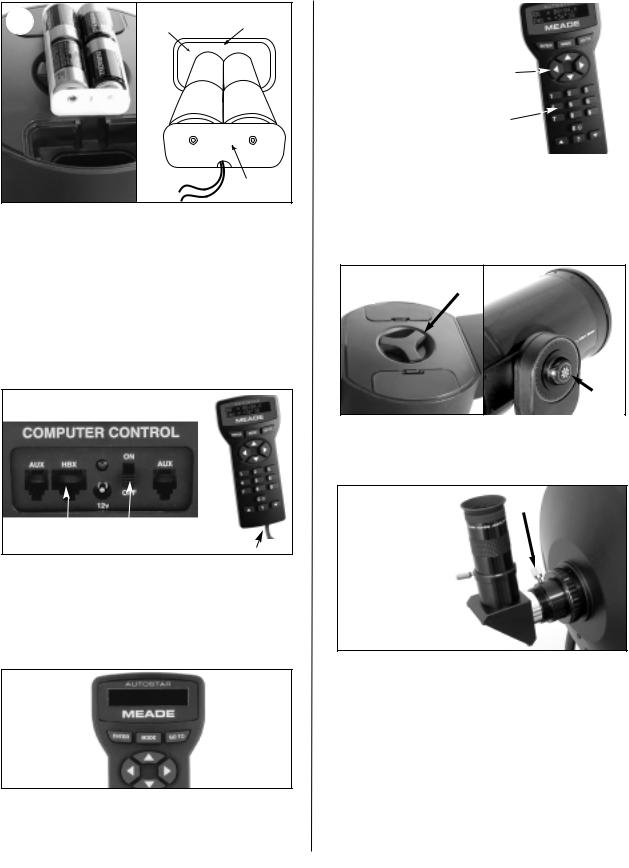
|
Battery |
|
|
Rib |
Compartment |
|
|
||
|
|
|
|
|
|
|
|
|
|
|
|
|
|
|
Battery
Holder
6.Remove the covers from both battery compartments located on top of the drive base and carefully lift the battery holders from their compartments, being mindful of the connector wires. Insert four (user-supplied) C-cell batteries into each battery holder (eight batteries total), oriented as shown on the diagram on the battery holder.
Return the battery holders to the battery compartment. See the diagram above. Replace the covers when you are done.
HBX Port |
ON/OFF |
Autostar Coil |
|
|
|
Cable Port |
|
|
|
|
|
7.Slide the computer control panel power switch to OFF, if necessary. Remove the Autostar handbox and the Autostar interface cable from the packing materials. Plug one end into the HBX port of the computer control panel and plug the other end into the Coil Cable port on the Autostar handbox.
(c) 00 Meade [2.0]
A U T O S T A R
8.Flip the Power Switch on the computer control panel to the ON position. The copyright message lights on Autostar’s LCD display.
|
|
Slew Speeds: |
|
|
|
|
|
|
|
|
|
|
|
|
|
|
|
|
|
Speed 9: Fast |
|
|
|
|
. |
Arrow |
|
|
|
|
. |
Keys |
|
|
|
|
. |
|
|
||
|
|
Speed 5: Medium |
|
|
|
|
. |
|
|
|
|
|
. |
|
|
|
|
|
. |
|
|
|
|
|
|
Speed 1: Slow |
Number |
|
|
|
|
|
Keys |
|
|
|
|
|
|
|
|
9.Press the key prompted by Autostar to accept the Sun warning. You can now use the Arrow keys to slew (move) the telescope up, down, right, or left. To change the telescope’s slew speed, press the Number keys. "9" is the fastest speed and "1" is slowest speed. See page 16 for more details.
R.A. Lock
Dec
Lock
10.Tighten, to a firm feel only, the Dec and R.A. locks (6 and 9, Fig. 1). See page 7 for more information. Remove the dust cover from the end of the telescope tube.
Thumb-screw
Thumbscrew
11.Remove the dust cap from the rear cell of the telescope. Thread the eyepiece holder into the rear cell thread. Slide the diagonal prism into the eyepiece holder and lock in place by turning the thumbscrew to a firm feel.
Place the Super Plössl 26mm eyepiece into the diagonal prism and tighten the attachment thumbscrew to a firm feel only.
Sight along the side of the telescope’s main tube to locate an object. Use the telescope’s focus knob (8, Fig. 1) to bring the object into focus. Practice using the Autostar’s Arrow keys to center an object in the telescope’s field of view.
5
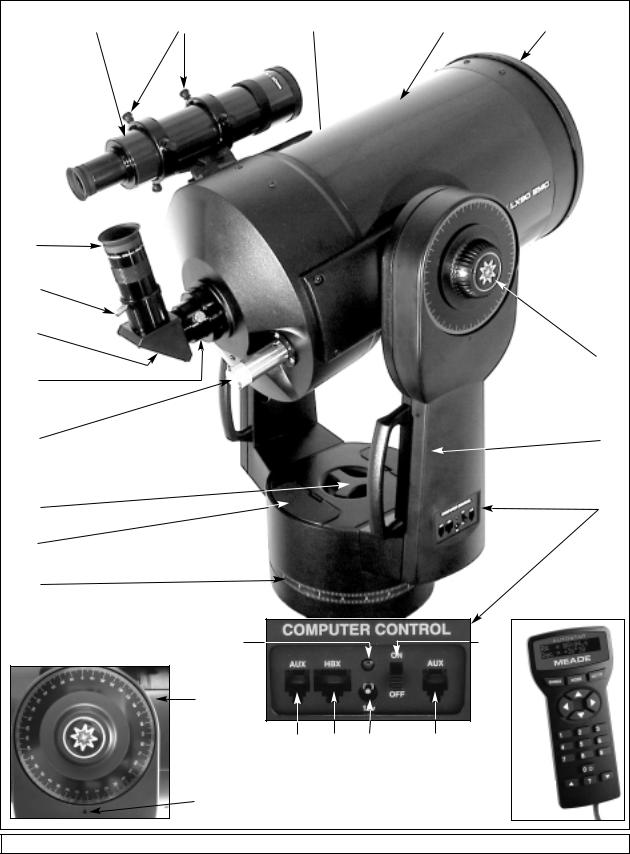
TELESCOPE FEATURES
|
|
see(not below)shown; |
|
|
|
|
|
|
|
|
|
|
|
|
|
|
|
|
|
|
|
|
|
|
|
|
|
|
|
|
|
|
|
|
|
|
|
|
|
|
|
|
|
|
|
|
|
|
|
|
|
|
|
|
|
|
|
|
|
|
|
|
|
|
|
|
|
|
|
Fig. 1: The LX90 Telescope and Autostar Handbox.
6

CAUTION:
Using products other than standard Meade accessories may cause damage to the telescope’s internal electronics and may void the Meade warranty.
LX90: Your Personal Window to the Universe
The Meade LX90 is an extremely versatile, high-resolution telescopes with features similar to those available only with larger and more specialized imaging systems. With pushbutton controls, automatic tracking of celestial objects, and software downloading capability, the LX90 telescope may be all the telescope ever required by many terrestrial and astronomical observers.
Your LX90 telescope reveals nature in an ever-expanding level of detail. Observe the feather structure of an eagle from 50 yards or study the rings of the planet Saturn from a distance of 800 million miles. Focus beyond the Solar System and observe majestic nebulae, ancient star clusters, remote galaxies, and even stars recently discovered to have planets orbiting about them. Meade LX90 telescopes are instruments fully capable of growing with your interest and are ideal for both the casual observer and serious astronomer alike.
Eyepiece - Place the Super Plössl 26mm eyepiece into the eyepiece holder or 90° diagonal prism (4, Fig. 1) and tighten in place with the thumbscrews. The eyepiece magnifies the image collected in the optical tube.
Eyepiece Holder Thumbscrew - Tightens the eyepiece in place. Tighten to a firm feel only.
Eyepiece Holder - Holds the eyepiece in place
Diagonal Prism - provides a more comfortable right angle viewing position. Slide the diagonal prism directly into the eyepiece holder (3, Fig. 1)
Optical Tube - The main optical component that gathers the light from distant objects and brings this light to a focus for examination through the eyepiece.
Dec Lock - Controls the manual vertical movement of the telescope. Turning the Dec lock counterclockwise unlocks the telescope enabling it to be freely rotated by hand about the vertical axis. Turning the Dec lock clockwise (to a firm feel only) prevents the telescope from being moved manually, but engages the vertical motor drive for Autostar operation.
NOTE: The Dec lock knob is a knurled knob located on the fork arm to the right of the focus knob (8, Fig. 1).
CAUTION: When loosening the Dec lock, be sure to support the optical tube (5, Fig. 1). The weight of the tube could cause the tube to swing through the fork arms suddenly.
Fork Arms - Hold the optical tube in place.
Focus Knob - Moves the telescope’s primary mirror in a finely-controlled motion to achieve precise image focus. The LX90 telescope can be focused on objects from a distance of about 25 ft. to infinity. Rotate the focus knob counterclockwise to focus on distant objects, and clockwise to focus on nearby objects.
R.A. Lock - Controls the manual horizontal rotation of the telescope. Turning the R.A. lock counterclockwise unlocks the telescope, enabling it to be freely rotated by hand about the horizontal axis. Turning the R.A. lock clockwise prevents the telescope from being rotated manually, and engages the horizontal motor drive for Autostar operation.
Right Ascension (R.A.) Setting Circle - See "APPENDIX A," page 45, for detailed information.
Declination (Dec) Setting Circle (on left fork arm) - See "APPENDIX A," page 45, for detailed information.
Declination Pointer - Line up the desired Declination setting with this pointer.
7
Computer Control Panel
A.Handbox (HBX) Port - Plug the Autostar coil cord (10, Fig. 2) into this port.
B.LED - The red power indicator light illuminates when power is supplied to the Autostar handbox and to the telescope’s motor drive.
C.ON/OFF Switch - Turns the Computer Control Panel and Autostar ON or OFF.
D.Auxiliary (AUX) Port (2) - Provides connection for current and future Meade accessories, such as the Meade Accessory Port Module. See “OPTIONAL ACCESSORIES,” page 39.
E.12v Power Connector - provides connection so that the telescope assembly may be powered from either a 12v DC auto cigarette light plug or from a standard 115v AC home outlet using optionally available 25' power cords.
Autostar with coil cord - See page 9 for a description of Autostar’s features.
Dust Cover- Gently pry the dust cover from the front lens of the telescope.
NOTE: The dust cover should be replaced after each observing session and the power turned off to the telescope. Verify that any dew that might have collected during the observing session has evaporated prior to replacing the dust cover.
Battery Compartments - Insert four (user-supplied) C-cell batteries in each compartment (eight batteries total).
Viewfinder - A low-power, wide-field sighting scope with crosshairs that enable easy centering of objects in the telescope eyepiece.
Viewfinder Collimation Screws - Use these screws to adjust the alignment of the viewfinder. See "Mounting and Adjusting the Viewfinder," page 14.
8
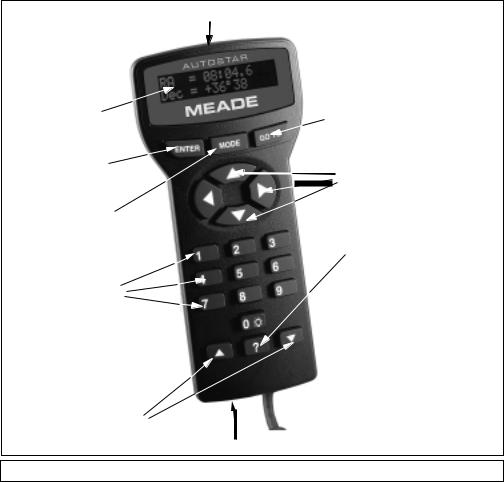
AUTOSTAR FEATURES
|
|
|
|
|
|
|
|
|
|
|
|
|
|


Fig. 2: The LX90 Autostar Handbox.
Tour the Cosmos with Just the Push of a Button
Control of the LX90 is through the operation of the standard-equipment Autostar. Nearly all functions of the telescope are accomplished with just a few pushes of Autostar’s buttons. Some of the major features of Autostar are:
•Automatically move the telescope to any of over 30,000 objects stored in the database or manually enter the astronomical coordinates of any celestial object.
•Take a guided tour of the best celestial objects to view on any given night of the year.
•Download the latest satellite data and software revisions directly from the Meade website (www.meade.com) and share software with other Autostar enthusiasts. (Requires option-
al #505 AstroFinder™ Software and Cable Connector Kit. See “OPTIONAL ACCESSORIES,” page 39.)
•Control your LX90 with your PC using an RS-232 interface.
•Access a glossary of astronomical terms.
•Calculate which eyepiece to use for optimum viewing of a celestial object.
•Mount the telescope in the “Alt/Az” mode (Altitude - Azimuth, or vertical - horizontal) for fully automatic tracking of celestial objects.
•Extensive long-exposure astrophotography and CCD imaging capability is available when the LX90 is mounted in the "Equatorial" (Polar) mode using an optional mounting wedge.
9

NOTE:
Throughout this manual, you will notice the term "Alt/Az." Alt/Az is frequently used to refer to Altitude (vertical) and Azimuth (horizontal). Alt/Az is just one of many methods used by amateur astronomers to help locate stars in the night sky.
TIP:
To manually enter the R.A. and Dec coordinates of an object:
Press and hold MODE for two seconds or more. The R.A. and Dec coordinates display. Press GO TO. "Object Position" and a set of coordinates displays. Then enter the R.A. and Dec coordinates of any celestial object using Number keys. As soon as the coordinates are entered, Autostar slews the telescope to the coordinates. Note that the telescope must be initialized (see page 17) and placed in the Home position (see page 17) for this procedure to operate properly.
The Autostar Computer Controller provides control of virtually every telescope function within a compact handbox. Autostar has soft-touch keys designed to have a positive feel. The LCD (Liquid Crystal Display) is backlit with a red LED (Light Emitting Diode) for easy viewing in the dark. The backlit display, key arrangement, and sequential database make Autostar extremely user friendly.
NOTE: Autostar does not require batteries; the telescope’s batteries supply power to Autostar.
2-Line LCD Display - Provides an interface between Autostar and the telescope.
•Top line: Lists the primary category or menu item.
•Bottom line: Contains a menu option or information about an object or subject, depending on which function is being performed.
ENTER Key - Accesses, in a sequential manner, the next menu or data level in the Autostar database. See “MOVING THROUGH AUTOSTAR'S MENUS,” page 17 and “AUTOSTAR’S MENU AND MENU OPTION DESCRIPTIONS,” page 23.
NOTE: If ENTER is pressed for two seconds or more and then released, Autostar emits a beep and “ENTER to Sync” is displayed. "ENTER to Sync" is relevant only after the telescope has been aligned and is pointing at an object. If the "ENTER to Sync" feature is accessed by mistake, press MODE to return to the previous screen. See “HIGH PRECISION,” page 27, for more details about this feature.
MODE Key - Returns to the previous menu or data level in the Autostar database until the top level, “Select Item," is reached. The MODE key is similar to the ESCAPE key on a computer.
NOTE: Pressing MODE while in the “Select Item” level moves Autostar to the topmost screen: “Select Item: Object.”
NOTE: If MODE is pressed and held for two seconds or more, information about the telescope's status is then available using the Scroll keys (7, Fig. 2), such as:
•Right Ascension and Declination (astronomical) coordinates (see page 45)
•Altitude (vertical) and Azimuth (horizontal) coordinates
•Local Time and Local Sidereal Time (LST)
•Timer and Alarm Status
•Accessory Port Module (APM) status. Information concerning these functions are described on the instruction sheets supplied with the APM.
Press MODE again to return to the previous menu.
GO TO Key - Slews (moves) the telescope to the coordinates of the currently selected object. While the telescope is slewing, the operation may be aborted at any time by pressing any key except GO TO. Pressing GO TO again resumes the slew to the object.
Arrow Keys - Slew the telescope in a specific direction (up, down, left, and right), at any one of nine different speeds. Speed selection is explained in “SLEW SPEEDS,” page 16. The following functions are also available with the Arrow keys:
•Data Entry - Use the Up and Down Arrow keys to scroll through the letters of the alphabet and numerical digits. The Down Arrow key starts with the letter "A" and the Up Arrow key starts with the digit "9." The Left and Right Arrow keys are used to move the blinking cursor left and right across the LCD display.
•Alt/Az Alignment - Use the Up and Down Arrow keys to move the telescope vertically up and down. The Left Arrow key rotates the telescope horizontally counterclockwise, while the Right Arrow key rotates it clockwise.
Number Keys - Input digits 0 - 9 and changes the slew speeds (see "SLEW SPEEDS," page 16). The "0" key also turns on and off the red utility light on the top of the handbox.
10

Scroll Keys - Accesses database options within a selected menu. The menu is displayed on the first line of the screen. Options within the menu are displayed, one at a time, on the second line. Press the Scroll keys to move through the options. Press and hold a Scroll key to move quickly through the options.
The Scroll keys also scroll through the letters of the alphabet and numerical digits.
NOTE: The Scroll Down key and the Down Arrow key move forward through the alphabet & digits (A to Z, 0 to 9). The Scroll Up key and the Up Arrow key move backward (Z to A, 9 to 0). Common symbols are also available in the list.
? Key - Accesses the "Help" file. "Help" provides on-screen information on how to accomplish whatever task is currently active.
Hold down the ? key and then follow the prompts on the display to access details of Autostar functions in the Help feature. The Help system is essentially an on-screen instruction manual.
If you have a question about an Autostar operation, e.g., INITIALIZATION, ALIGNMENT, etc., hold down the ? key and follow the directions that scroll on the second line of the LCD screen. When a word appears in [brackets], press ENTER to access the Autostar Glossary. A definition or more detailed information is displayed. Press MODE to return to the scrolling Autostar Help display.
When satisfied with the Help provided, press MODE to return to the original screen and continue with the chosen procedure.
Coil Cord Port - Plug one end of the Autostar coil cord into this port (11, Fig. 2) located at the bottom of the Autostar handbox.
Coil Cord - Plug one end of the Autostar coil cord into the HBX port (13A, Fig. 1) of the computer control panel of the telescope.
RS-232 Port - plug an RS-232 cable into Autostar for downloading functions such as "Download" or "Clone." See page 28 for more details.
Utility Light - Use this built-in red light to illuminate star charts and accessories without disturbing your eye's adaptation to darkness.
LX90 TIPS
Join an Astronomy Club
Attend a Star Party
One of the fun ways to learn about astronomy is to join an astronomy club. Check your local newspaper, school, library, or telescope dealer/store to find out if there’s a club in your area.
At club meetings, you will meet other astronomy enthusiasts with whom you will be able to share your discoveries. Clubs are an excellent way to learn more about observing the sky, to find out where the best observing sites are, and to compare notes about telescopes, eyepieces, filters, tripods, and so forth.
Often, club members are excellent astrophotographers. Not only will you be able to see examples of their art, but you may even be able to pick up some “tricks of the trade” to try out on your LX90 telescope. See page 38 for more information about photography with the LX90.
Many groups also hold regularly scheduled Star Parties at which you can check out and observe with many different telescopes and other pieces of astronomical equipment.
Magazines such as Sky & Telescope and
Astronomy print schedules for many popular Star Parties around the United States and
Canada.
11

GETTING STARTED
Parts Listing
Getting the telescope ready for first observations requires only a few minutes. When first opening the packing box, note carefully the following parts:
•LX90 Telescope with fork mount system
•Autostar handbox and interface coil cord
•8 x 50mm viewfinder assembly
•Eyepiece holder and 1.25 diagonal prism
•Super Plössl 26mm eyepiece, packed in a plastic storage container
•Variable height tripod and mounting base
•Set of hex wrenches
How to Attach the Tripod to the Telescope Assembly
The telescope’s fork mount attaches directly to the field tripod. The telescope in this way is mounted in an “Altazimuth” (“Altitude-Azimuth,” or “vertical-horizontal”) format. The telescope in this configuration moves along vertical and horizontal axes, corresponding respectively to the Declination (vertical) and Right Ascension (horizontal) axes in an astronomical observing mode.
The field tripod also can be used in conjunction with the optional equatorial wedge (see "EQUATORIAL WEDGE," page 47) for long exposure astrophotography. The equatorial wedge permits alignment of the telescope’s Polar Axis with the Celestial Pole (or North Star).
1.After removing the field tripod from its shipping carton, stand the tripod vertically, with the tripod feet down and with the tripod still fully collapsed (see Fig. 3). Grasp two of the tripod legs and, with the full weight of the tripod on the third leg, gently pull the legs apart to a fully open position.
2.Thread in the 6 lock-knobs (2 on each tripod leg) near the foot of each tripod leg (Fig. 3). These lock-knobs are used to fix the height of the inner, extendible tripod leg sections.
NOTE: Tightening to a firm-feel is sufficient; over-tightening may result in stripping of the knob threads or damage to the tripod legs and results in no additional strength.
3.The spreader bar (4, Fig. 3) has been removed for shipment. To install, first remove the threaded rod (2, Fig.3) from the tripod head (1, Fig. 3); a small piece of plastic holds the threaded rod in place. Remove the small plastic bag that is stapled to the threaded rod. This bag contains the “C” clip retainer and an extra clip.
4.Slide the spreader bar onto the threaded rod (note the correct orientation as shown in Fig. 4) and position the threaded rod back through the tripod head. Place the clip retainer ( a “C” clip) into the slot in the threaded rod. This clip holds the threaded rod in place. See Fig. 3.



Fig. 3: Field Tripod. (1) Tripod Head;
(2) Threaded Rod; (3) Tension Knob;
(4) Spreader Bar; (5) Lock Knobs;
Fig. 4: Attaching the telescope to the tripod. Note the orientation of the spreader bar.
12
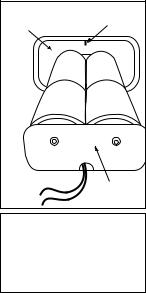
Battery
Compartment Rib
Battery
Holder
Fig. 5: Four C-cell
batteries mounted inside one of the battery holders . Note position of rib in the battery compartment.
5.Position the spreader bar so that the 3 arms of the spreader bar line up with the 3 tripod legs.
6.Place the entire telescope onto the top of the tripod head, and insert the threaded rod into the central hole in the bottom of the drive base of the telescope. Tighten the tension knob (3, Fig. 3); firm tightening of the tension knob is sufficient to result in rigid positioning of the tripod legs.
7.To vary the tripod height, loosen the 6 lock-knobs, slide the 3 inner tripod leg sections out to the desired height, and firmly re-tighten (but do not overtighten) the 6 lock-knobs.
To collapse the tripod (after removing the telescope and equatorial wedge, if applicable) for storage follow these steps:
1.Rotate the spreader bar 60° from its assembled position, so that one spreader bar arm is located between each adjacent pair of tripod legs.
2.At the base of the tripod is a 3-vane extension strut system, with a circular hub at its center (6, Fig. 3). Grasp the tripod head (1, Fig. 3) with one hand and, with the other hand, pull directly “up” on the central hub of the extension strut system. This operation will cause the tripod legs to move inward to a collapsed position.
Precautionary Notes
•If the tripod does not seem to extend or collapse easily, do not force the tripod legs in or out. By following the instructions above, the tripod will function properly, but if you are unclear on the proper procedure, forcing the tripod into an incorrect position may damage the extension strut system.
•Do not overtighten the 6 lock-knobs used to fix the inner tripod leg sections at various heights. Tighten to a firm feel only.
•Be sure the spreader bar (4, Fig. 3) is not upside-down on the threaded rod.
How to Assemble Your Telescope
Assembly of the LX90 telescope requires eight C-cell (user-supplied) batteries or optional power cords (25') to a standard 115v home outlet or to a 12v DC automobile cigarette lighter plug. See the Instruction Sheets supplied with the optional power cords for installation information. To install batteries:
1.Unlock the Dec lock (6, Fig. 1) to move the optical tube (5, Fig. 1) through the fork arms. Move the optical tube to the position depicted in Fig. 1 and relock the Dec lock.
2.Remove the battery compartment covers (16, Fig. 1) and carefully remove the battery holder, being mindful of the connector wires. Insert four C-cell batteries into each battery holder, oriented as shown on the diagram on the battery slots inside the battery holder. Return
the battery holders to their respective compartments and replace the covers.
See Fig. 5 for the proper orientation of the holder. Do not force the holder into the battery compartment. If a holder does not slip easily into the compartment, you may have inserted the holder incorrectly. Replace the compartment covers when you are done.
CAUTION: Use care to install batteries as indicated by the battery compartment. Follow battery manufacturer's precautions. Do not install batteries backwards or mix new and used batteries. Do not mix battery types. If these precautions are not followed, batteries may explode, catch fire, or leak. Improperly installed batteries void your Meade warranty. Always remove the batteries if they are not to be used for a long period of time.
3.Be certain that the power switch on the computer control panel (13C, Fig. 1) is in the OFF position. Plug the coil cord of the Autostar Controller into the HBX port (13A, Fig. 1).
NOTE: Autostar does not require batteries; the telescope’s batteries supply power to Autostar.
4.Remove the dust cap from the rear cell of the telescope. Thread the eyepiece holder into the rear cell thread. Slide the diagonal prism into the eyepiece holder and lock in place by turning the thumbscrew to a firm feel.
5.Remove the Super Plössl 26mm eyepiece (1, Fig. 1) from its container and place it in the diagonal prism (3, Fig. 1). Tighten the thumbscrew (2, Fig. 1) to a firm feel only.
6.Remove the dust cover (15, Fig. 1) from the optical tube assembly (5, Fig. 1) by gently prying it off.
13
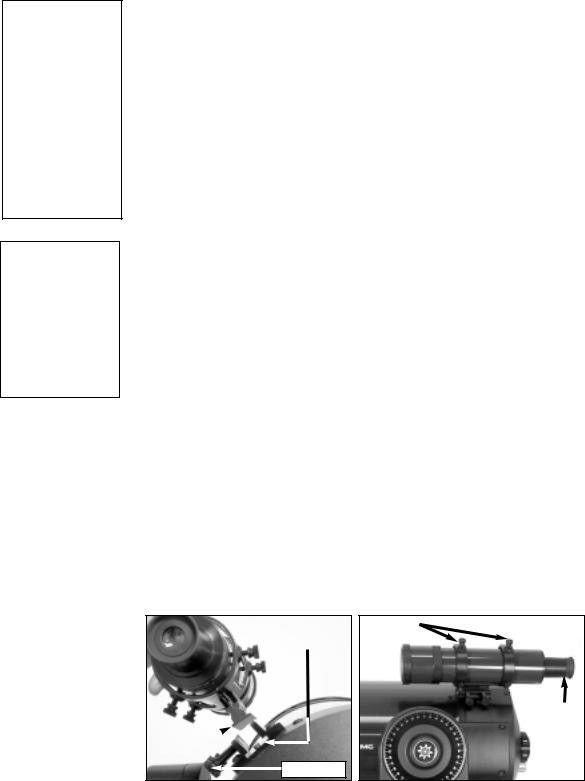
NEVER point the telescope directly at or near the Sun at any time! Observing the Sun, even for the smallest fraction of a second, will result in instant and irreversible eye damage, as well as physical damage to the telescope itself.
NOTE:
For a list of magnification ratings of the eyepieces available for the LX90 telescope, see "OPTIONAL ACCESSORIES," page 39.
Choosing an Eyepiece
A telescope’s eyepiece magnifies the image formed by the telescope’s main optics. Each eyepiece has a focal length, expressed in millimeters, or “mm.” The smaller the focal length, the higher the magnification. For example, an eyepiece with a focal length of 9mm has a higher magnification than an eyepiece with a focal length of 26mm.
Your telescope comes supplied with a Super Plössl 26mm eyepiece which gives a wide, comfortable field of view with high image resolution.
Low power eyepieces offer a wide field of view, bright, high-contrast images, and eye relief during long observing sessions. To find an object with a telescope, always start with a lower power eyepiece such as the Super Plössl 26mm. When the object is located and centered in the eyepiece, you may wish to switch to a higher power eyepiece to enlarge the image as much as practical for prevailing seeing conditions. For information about optional eyepieces for the LX90, see "OPTIONAL ACCESSORIES," page 39.
NOTE: Seeing conditions vary widely from night-to-night and site-to-site. Turbulence in the air, even on an apparently clear night, can distort images. If an image appears fuzzy and ill-defined, back off to a lower power eyepiece for a more wellresolved image (Fig. 7a and 7b).
The power, or magnification of a telescope is determined by the focal length of the telescope and the focal length of the eyepiece being used. To calculate eyepiece power, divide the telescope's focal length by the eyepiece's focal length. For example, a 26mm eyepiece is supplied with the LX90. The focal length of the LX90 is 2000mm (see "Specifications," page 44).
Eyepiece Power = |
Telescope Focal Length |
= |
2000mm |
= 77X |
|
|
|||
Eyepiece Focal Length |
26mm |
|||
The eyepiece power, or magnification is therefore 77X (approximately).
Mounting and Adjusting the Viewfinder
To align the viewfinder, perform steps 1 through 5 during the daytime; perform step 6 at night.
1.Slide the track on the bottom of the viewfinder into the slot in the viewfinder mounting assembly. See Fig. 6a. To secure the viewfinder to the mounting assembly, tighten the two thumbscrews (Fig. 6a) to a firm feel only.
2.If you have not already done so, insert the Super Plössl 26mm eyepiece into the diagonal prism.
3.Unlock the R.A. (9, Fig. 1) and Dec (6, Fig. 1) locks so that the telescope moves freely on both axes.
4.Point the telescope at some well-defined and stationary land object at least 200 yards distant, such as the top of a telephone pole or street sign. Center the object in the telescope eyepiece. Re-tighten the R.A. and Dec locks.
5.Look through the viewfinder eyepiece (Fig. 6b) and loosen or tighten, as appropriate, one or more of the viewfinder collimation screws (Fig. 6b) until the viewfinder crosshairs are precisely centered on the object you previously centered in the telescope eyepiece.
6.Check this alignment on a celestial object, such as the Moon or a bright star, and make any necessary refinements, using the method outlined in steps 3 and 4.
Collimation
Mounting Screws
Slot
Viewfinder
Eyepiece
Track 
Thumbscrews
Fig. 6a: Viewfinder Assembly. |
|
Fig. 6b: Viewfinder Assembly. |
|
|
|
|
|
|
14
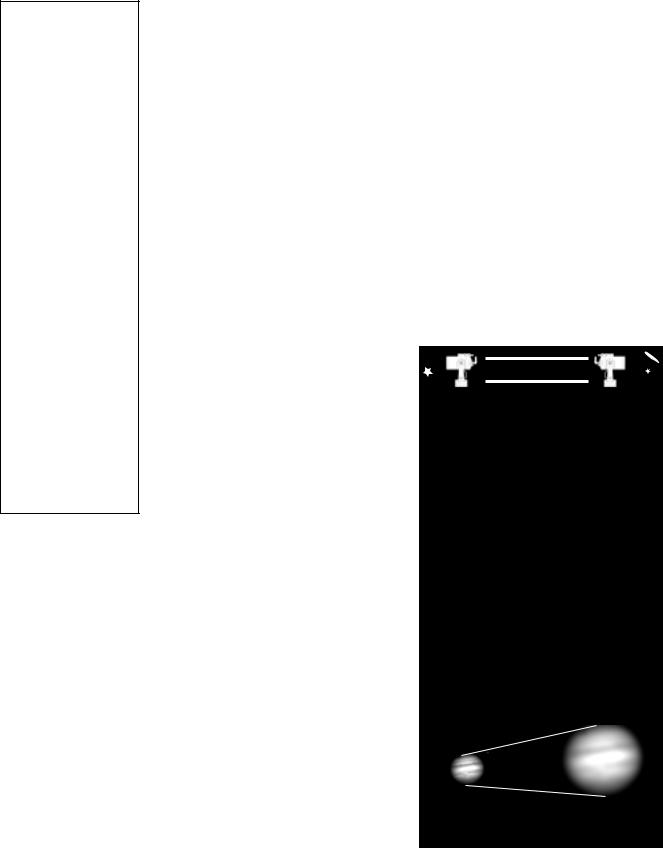
IMPORTANT NOTE:
Objects appear upside-down and reversed left-for-right when observed in the viewfinder and also in the eyepiece when inserted directly into the (straight-through) eyepiece holder – with the diagonal prism in place, images will be right- side-up, but reversed left-for-right.
This image inversion is of no consequence when observing astronomical objects and, in fact, all astronomical telescopes yield inverted images.
During terrestrial observing, where a fully-correctly-oriented image (right-side-up and correct left-for- right) is desirable, an optional #928 45° Erecting Prism is available. See “OPTIONAL ACCESSORIES,” page 39.
OBSERVING
Observing By Moving the Telescope Manually
If you wish to observe a distant land object, such as a mountain top or a bird, you can observe by merely pointing the telescope and looking through the eyepiece.
1.Loosen the telescope’s R.A. lock (9, Fig. 1) and Dec lock (6, Fig. 1).
2.Move your telescope to observe distant street signs, mountains, trees, and other structures. Use your viewfinder to to help site-in on an object.
3.Center the object in the viewfinder’s crosshairs and then in the telescope eyepiece. When the object is centered in your eyepiece, remember to re-tighten the R.A. and Dec locks.
4.Practice focusing objects with the focus knob (8, Fig. 1).
5.Once you get a feel for how your telescope moves and focuses, try to view something more challenging, like a bird or a distant moving train.
NOTE: Viewing conditions vary widely from night-to-night and site-to-site. Turbulence in the air, even on an apparently clear night, can distort images. Lowpower eyepieces, such as the Super Plössl 26mm supplied with your telescope, are better suited to resolving images in poor viewing conditions.
You can also observe stars and objects in the night sky using this method, but note that objects begin to slowly drift across the eyepiece field. This motion is caused by the rotation of the Earth. As you become familiar with the Autostar handbox operation, you can counteract the drift using the automatic tracking feature in the Autostar Setup menu (see "TO TRACK AN OBJECT AUTOMATICALLY," page 18), or by using Autostar's GO TO capabilities (see "GO TO SAT- URN," page 20). 



LX90 TIPS
Terrestrial Observing
The LX90 ia an excellent high-resolution, terrestrial (land) telescopes. Viewing terrestrial objects requires looking along the Earth's surface through heat waves. These heat waves often cause degradation of image quality. Lower power eyepieces, like the Super Plössl 26mm eyepiece, magnify these heat waves less than higher power eyepieces. Therefore, lower power eyepieces provide a steadier, higher quality image. If the image is fuzzy or ill-defined, reduce to a lower power eyepiece, where the heat waves do not have such an effect on image quality. Observing in early morning hours, before the ground has built up internal heat, produces better viewing conditions than during late afternoon hours.
Observing Using Autostar's Arrow Keys
You may observe land and astronomical objects using Autostar's Arrow keys to move the telescope.
1.Make sure that the Dec and R.A. locks (6 and 9, Fig. 1) are secured as described on page 5.
2.Verify that Autostar is properly connected to your telescope. See “HOW TO ASSEMBLE YOUR TELESCOPE,” page 13.
Too Much Power?
Can you ever have too much power? If the type of power you’re referring to is eyepiece magnification, yes, you can! The most common mistake of the beginning observer is to “overpower” a telescope by using high magnifications which the telescope’s aperture and atmospheric conditions can not reasonably support. Keep in mind that a smaller, but bright and well-resolved image is far superior to one that is larger, but dim and poorly resolved (see below). Powers above 400X should be employed only under the steadiest atmospheric conditions.
Autostar can calculate the best eyepiece for you to use. Try out the “Eyepiece Calc” feature in the Utilities menu.
Most observers should have three or four additional eyepieces to achieve the full range of reasonable magnifications possible with the LX90 telescopes. See “OPTIONAL ACCESSORIES,” page 39.
Fig. 7a & b: Jupiter; example of too much magnification.
15

NOTE:
Do not look through the telescope's eyepiece or viewfinder while it is rapidly moving. Children should always have adult supervision while observing.
3.Flip the telescope power switch to the ON position.
The Autostar screen is activated and a copyright message displays briefly, followed by a short beep. Then Autostar takes a few moments to start up the system.
4.A message displays that warns not to look at the Sun. At the end of this message, press the key prompted by Autostar to signify that the message has been read and understood.
5.The Arrow keys are now activated. Press the Arrow keys (5, Fig. 2) to slew (move) the telescope up, down, right, or left.
6.Press a Number key (8, Fig. 2) to change the telescope’s slew speed. See "SLEW SPEEDS," below, for more information.
7.Use the viewfinder (17, Fig. 1) to locate an object and practice using the Autostar’s Arrow keys to center the object in the telescope’s field of view.
8.Use the telescope’s focus knob (8, Fig. 1) to bring the object into focus.
Slew Speeds
Autostar has nine slew speeds that are directly proportional to the sidereal rate and have been calculated to accomplish specific functions. Pressing a Number key changes the slew speed, which is shown for about two seconds on Autostar’s display.
The nine available speeds are:
Number Key 1 |
= |
1x |
= |
1 x sidereal (0.25 arc-min/sec or 0.004°/sec) |
Number Key 2 |
= |
2x |
= |
2 x sidereal (0.5 arc-min/sec or 0.008°/sec) |
Number Key 3 |
= |
8x |
= |
8 x sidereal (2 arc-min/sec or 0.033°/sec) |
Number Key 4 |
= |
16x |
= |
16 x sidereal (4 arc-min/sec or 0.067°/sec) |
Number Key 5 |
= |
64x |
= |
64 x sidereal (16 arc-min/sec or 0.27°/sec) |
Number Key 6 |
= 128x |
= |
32 arc-min/sec or 0.5°/sec |
|
Number Key 7 |
= |
1.5° = |
90 arc-min/sec or 1.5°/sec |
|
Number Key 8 |
= |
3° = |
180 arc-min/sec or 3°/sec |
|
Number Key 9 |
= |
Max |
= |
390 arc-min/sec or 6.5°/sec) |
Speeds 1, 2, or 3: Best used for fine centering of an object in the field of view of a higher power eyepiece, such as a 12mm or a 9mm eyepiece.
Speeds 4, 5, or 6: Enables centering an object in the field of a low-to-moderate power eyepiece, such as the standard Super Plössl 26mm.
Speeds 7 or 8: Best used for rough centering of an object in the eyepiece.
Speed 9: Moves the telescope quickly from one point in the sky to another
Observe the Moon
Point your telescope at the Moon (note that the Moon is not visible every night) and practice using the Arrow keys and the slew speeds to view different features. The Moon contains many interesting features, including craters, mountain ranges, and fault lines. The best time to view the Moon is during its crescent or half phase. Sunlight strikes the Moon at an angle during these periods and adds a depth to the view. No shadows are seen during a full Moon, causing the overly bright surface to appear flat and rather uninteresting. Consider the use of a neutral density Moon filter when observing the Moon. Not only does it cut down the Moon's bright glare, but it also enhances contrast, providing a more dramatic image.
16
